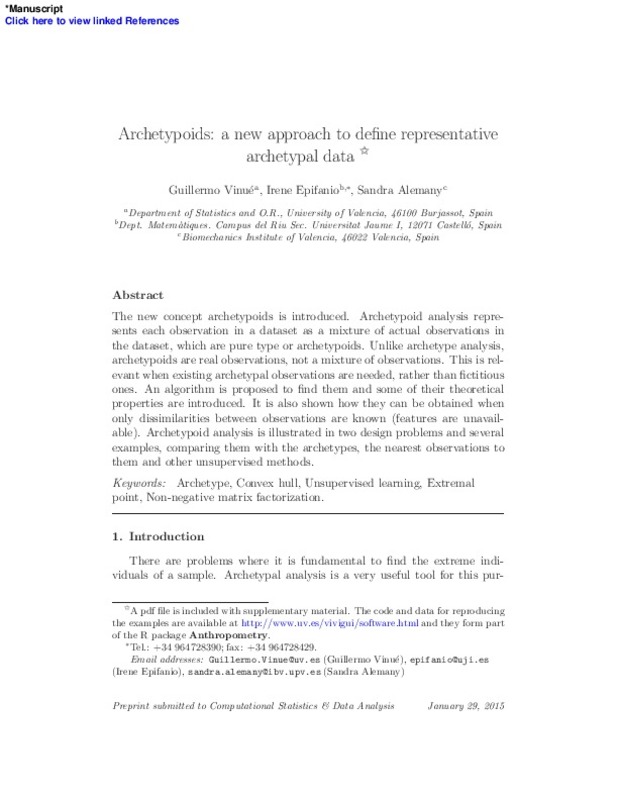JavaScript is disabled for your browser. Some features of this site may not work without it.
Buscar en RiuNet
Listar
Mi cuenta
Estadísticas
Ayuda RiuNet
Admin. UPV
Archetypoids: A new approach to define representative archetypal data
Mostrar el registro sencillo del ítem
Ficheros en el ítem
| dc.contributor.author | Vinue, G.
|
es_ES |
| dc.contributor.author | Epifanio, I.
|
es_ES |
| dc.contributor.author | Alemany Mut, Mª Sandra
|
es_ES |
| dc.date.accessioned | 2016-09-28T06:39:44Z | |
| dc.date.available | 2016-09-28T06:39:44Z | |
| dc.date.issued | 2015 | |
| dc.identifier.issn | 0167-9473 | |
| dc.identifier.uri | http://hdl.handle.net/10251/70519 | |
| dc.description.abstract | [EN] The new concept archetypoids is introduced. Archetypoid analysis represents each observation in a dataset as a mixture of actual observations in the dataset, which are pure type or archetypoids. Unlike archetype analysis, archetypoids are real observations, not a mixture of observations. This is relevant when existing archetypal observations are needed, rather than fictitious ones. An algorithm is proposed to find them and some of their theoretical properties are introduced. It is also shown how they can be obtained when only dissimilarities between observations are known (features are unavailable). Archetypoid analysis is illustrated in two design problems and several examples, comparing them with the archetypes, the nearest observations to them and other unsupervised methods. | es_ES |
| dc.description.sponsorship | The authors would like to thank Juan Domingo from the University of Valencia for providing the binary images of women’s trunks. They would also like to thank the Biomechanics Institute of Valencia for providing them with the dataset and the Spanish Ministry of Health and Consumer Affairs for having promoted and coordinated the ‘‘Anthropometric Study of the Female Population in Spain’’. The authors are also grateful to the Associate Editor and two reviewers for their very constructive suggestions, which have led to improvements in the manuscript. This work has been partially supported by Grant DPI2013-47279-C2-1-R. | |
| dc.language | Inglés | es_ES |
| dc.publisher | Elsevier | es_ES |
| dc.relation.ispartof | Computational Statistics and Data Analysis | es_ES |
| dc.rights | Reserva de todos los derechos | es_ES |
| dc.subject | Archetype | es_ES |
| dc.subject | Convex hull | es_ES |
| dc.subject | Unsupervised learning | es_ES |
| dc.subject | Extremal point | es_ES |
| dc.subject | Non-negative matrix factorization | es_ES |
| dc.title | Archetypoids: A new approach to define representative archetypal data | es_ES |
| dc.type | Artículo | es_ES |
| dc.identifier.doi | 10.1016/j.csda.2015.01.018 | |
| dc.relation.projectID | info:eu-repo/grantAgreement/MINECO//DPI2013-47279-C2-1-R/ES/HERRAMIENTAS PARA LA PREDICCION DE LA TALLA Y EL AJUSTE DE ROPA INFANTIL A PARTIR DE LA RECONSTRUCCION 3D DEL CUERPO Y DE TECNICAS BIG DATA/ | es_ES |
| dc.rights.accessRights | Abierto | es_ES |
| dc.contributor.affiliation | Universitat Politècnica de València. Instituto Universitario Mixto de Biomecánica de Valencia - Institut Universitari Mixt de Biomecànica de València | es_ES |
| dc.description.bibliographicCitation | Vinue, G.; Epifanio, I.; Alemany Mut, MS. (2015). Archetypoids: A new approach to define representative archetypal data. Computational Statistics and Data Analysis. 87:102-115. https://doi.org/10.1016/j.csda.2015.01.018 | es_ES |
| dc.description.accrualMethod | S | es_ES |
| dc.relation.publisherversion | http://dx.doi.org/10.1016/j.csda.2015.01.018 | es_ES |
| dc.description.upvformatpinicio | 102 | es_ES |
| dc.description.upvformatpfin | 115 | es_ES |
| dc.type.version | info:eu-repo/semantics/publishedVersion | es_ES |
| dc.description.volume | 87 | es_ES |
| dc.relation.senia | 305950 | es_ES |
| dc.contributor.funder | Ministerio de Economía y Competitividad |






![[Cerrado]](/themes/UPV/images/candado.png)


